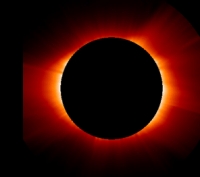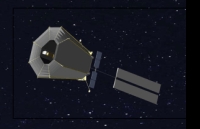
One way to see a dim planet near a bright star is to blot
out the star using a device called a coronagraph. This happens
to our Sun whenever the Moon moves in front of it during
a total solar eclipse. The coronagraph uses a disk to create
an artificial eclipse. Since it is one of the few methods
that will allow an extra-solar planet to be observed directly,
coronagraphs are being developed for use aboard telescopes
in space.
 The Sun before and after a coronagraph has covered its
disk to observe the outer atmosphere, or corona. Nearby stars
are millions of times farther away than the Sun, which means
they appear millions of times smaller as observed from Earth.
Blotting out a star and detecting a nearby planet with a
coronagraph presents a tremendous technical challenge.
The Sun before and after a coronagraph has covered its
disk to observe the outer atmosphere, or corona. Nearby stars
are millions of times farther away than the Sun, which means
they appear millions of times smaller as observed from Earth.
Blotting out a star and detecting a nearby planet with a
coronagraph presents a tremendous technical challenge.
 Scheduled for launch in 2015, the Terrestrial Planet Finder
(TPF) will use an advanced coronagraph to view Earth-like
planets directly, measuring characteristics that may signal
the presence of life. A second TPF mission using different
optical techniques may be launched around 2019.
Scheduled for launch in 2015, the Terrestrial Planet Finder
(TPF) will use an advanced coronagraph to view Earth-like
planets directly, measuring characteristics that may signal
the presence of life. A second TPF mission using different
optical techniques may be launched around 2019.



